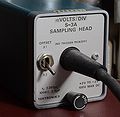S-3: Difference between revisions
No edit summary |
No edit summary |
||
| Line 17: | Line 17: | ||
Optional 10× or 100× attenuator tips (010-0364-00, 010-0365-00) provide extended input voltage range; the optional [[VP-2]] voltage pickoff converts it to a 50 Ω feed-through sampling head. | Optional 10× or 100× attenuator tips (010-0364-00, 010-0365-00) provide extended input voltage range; the optional [[VP-2]] voltage pickoff converts it to a 50 Ω feed-through sampling head. | ||
{{BeginSpecs}} | |||
{{Spec | Rise time | ≤350 ps (×10, ≤400 ps; ×100, ≤500 ps) }} | |||
{{Spec | Input impedance | 100 kΩ // 2.3 pF (×10, 1 MΩ // 2 pF; ×100, 1 MΩ // 1.7 pF) }} | |||
{{Spec | Maximum signal | 2 V<sub>p-p</sub> (×10, 20 V<sub>p-p</sub>; ×100, 200 V<sub>p-p</sub>) }} | |||
{{Spec | Maximum safe input | max. ±100 V, max. sine input 20 V<sub>p-p</sub> (×10 or ×100, max. ±350 V, max. sine input 200 V<sub>p-p</sub>) }} | |||
{{Spec | Features | | |||
* no trigger pickoff for internal triggering | |||
* offset voltage of either ±1 V or ±2 V (at ×1) can be selected via a toggle switch on the front panel | |||
}} | |||
{{EndSpecs}} | |||
==Differences between S-3 and S-3A == | |||
The S-3A sampling head has a 10× improvement in baseline shift due to cable flexing. | |||
== Differences between S-3 and S-3A == | |||
The S-3A sampling head has | |||
All other specifications are identical to the ordinary S-3. | All other specifications are identical to the ordinary S-3. | ||
| Line 38: | Line 35: | ||
but some changes are also made to the circuits in the body of the probe. | but some changes are also made to the circuits in the body of the probe. | ||
== Difference between the S-3 and the P6038 == | ==Difference between the S-3 and the P6038 == | ||
The S-3 probe contains a compensated attenuator before the sampling bridge. | The S-3 probe contains a compensated attenuator before the sampling bridge. | ||
The [[P6038]] does not. | The [[P6038]] does not. | ||
The S-3 probe has a JFET buffer between the holding cap and the probe cable. | The S-3 probe has a JFET buffer between the holding cap and the probe cable. | ||
The P6038 does not. | The P6038 does not. | ||
Both use the [[152-0368-00]] sampling bridge. | Both use the [[152-0368-00]] sampling bridge. The sampling pulse is generated by a [[snap-off diode]] ([[152-0368-00]]). | ||
== Repair of Sampling Diodes == | == Repair of Sampling Diodes == | ||
| Line 49: | Line 46: | ||
==Pictures== | ==Pictures== | ||
'''S-3''' | |||
<gallery> | |||
Tek s3 probe sample bridge.jpg|S-3 probe sampling bridge | |||
Tek s3 sample bridge2.jpg|S-3 probe sampling bridge | |||
S3_frontend.png | S-3 frontend circuit | |||
</gallery> | |||
'''S-3A''' | |||
<gallery> | <gallery> | ||
S3a attenuator.jpg|010-0364-00 ×10 attenuator for S-3A | S3a attenuator.jpg|010-0364-00 ×10 attenuator for S-3A | ||
S3a box front.jpg|Front | S3a box front.jpg|Front | ||
| Line 58: | Line 62: | ||
S3a strobe board.jpg|S-3A strobe board | S3a strobe board.jpg|S-3A strobe board | ||
S3a probe_internal_bothsides.jpg|S-3A probe both sides | S3a probe_internal_bothsides.jpg|S-3A probe both sides | ||
</gallery> | </gallery> | ||
[[Category:7000 and 3S series sampling heads]] | [[Category:7000 and 3S series sampling heads]] | ||
Revision as of 11:40, 21 April 2022
The Tektronix S-3 sampling head is a plug-in head for use with the 7000 series sampling plug-ins or the Type 3S2, 3S5, and 3S6 samplers.
The plug-in includes a permanently attached 1× probe with the sampling bridge enclosed in the probe. Optional 10× or 100× attenuator tips (010-0364-00, 010-0365-00) provide extended input voltage range; the optional VP-2 voltage pickoff converts it to a 50 Ω feed-through sampling head.
Key Specifications
| Rise time | ≤350 ps (×10, ≤400 ps; ×100, ≤500 ps) |
|---|---|
| Input impedance | 100 kΩ // 2.3 pF (×10, 1 MΩ // 2 pF; ×100, 1 MΩ // 1.7 pF) |
| Maximum signal | 2 Vp-p (×10, 20 Vp-p; ×100, 200 Vp-p) |
| Maximum safe input | max. ±100 V, max. sine input 20 Vp-p (×10 or ×100, max. ±350 V, max. sine input 200 Vp-p) |
| Features |
|
Differences between S-3 and S-3A
The S-3A sampling head has a 10× improvement in baseline shift due to cable flexing. All other specifications are identical to the ordinary S-3.
The major differences in design involves the gate board in the box part of the probe, but some changes are also made to the circuits in the body of the probe.
Difference between the S-3 and the P6038
The S-3 probe contains a compensated attenuator before the sampling bridge. The P6038 does not. The S-3 probe has a JFET buffer between the holding cap and the probe cable. The P6038 does not. Both use the 152-0368-00 sampling bridge. The sampling pulse is generated by a snap-off diode (152-0368-00).
Repair of Sampling Diodes
Individuals have reported success in replacing the S-3 sampling diodes with Agilent matched pair Schottky diodes.
Pictures
S-3
-
S-3 probe sampling bridge
-
S-3 probe sampling bridge
-
S-3 frontend circuit
S-3A
-
010-0364-00 ×10 attenuator for S-3A
-
Front
-
S-3A probe
-
S-3A probe internal
-
S-3A probe internal
-
S-3A strobe board
-
S-3A probe both sides




